
Animal Physiology Chapter1 Introduction Teachering Hours 2 hours Intensive Teaching:Subjects studied in animal physiology:Regulation of functions;Internal environment and hemeostasis Nodi for student Regulation model and its mechanism of animal body functions. Seactionl Subjects,Methods and Tasks Studied of Animal Physiology 1 The content of animal physiology Physiology is the science of studying the functional activities and its mechanisms in biological body.to explain how they are regulated and integrated. Animal physiology is to study the living phenomena and the function activities of normal animal. Animal physiology is composed of studying on three levels of function: 1.1 cellular and molecule levels The basic living unit of the body is the cell,and each organ is an aggregation of many different cells held together by intercellular supporting structures.Cell level research to understand the function of the organ Molecular level research to study the functions of cells. 1.2 organ and system levels The goals are to explore the effects of organs and systems for animal body and how to performe their activities,and the affecting factors. 1.3 integral levels The aims are to study interactions among organs and systems,and interaction between animal body and environment 2 Purpose of Resreach To garsp the rule of vital activities in animal body,to prevent and treat disease in livestock and poultry effectively,and promote the development of stockbreeding. 3 Resreach Methods 3.1 acute experiments Experiment performed on animals under anesthesia or with transection of the brain is called acute experiment: (1)in vitro:Experiments performed on an isolated tissue or organ (2)in vivo:Experiments performed on the whole body. 3.2 chronic experiments Chronic experiments shoud be performed on a conscious subject for a long period of time. -1- This document is produced by trial version of Print2Flash.Visit www.print2flash.com for more information

Seaction2 Regulation of body functions Regulation:the ability of an organism to maintain a stable internal condition in a constantly changing environment Three types: 1)Chemical (hormonal)Regulation:a regulatory process performed by hormone or active chemical substance in blood or tissue. It response slowly,acts extensively and lasts for a long time 2)Nervous Regulation:a process in which body functions are controlled by nerve system Pathway:nerve reflex Reflex:the basic active manner of nervous regulation Reflex arc:including 5 parts:Receptor-->afferent->reaction center->efferent->Effector Types:unconditioned reflex and conditioned reflex Example:baroreceptor reflex of arterial blood pressure Characteristics:response fast;acts exactly or locally,last for a short time 3)Autoregulation:a tissue or an organ can directly respond to environmental changes that are independent of nervous and hormonal control. Seaction3 Internal Environment and Hemeostasis 1.Body fluid:include intracellular fluid and extracellular fluid. 2.Internal environment and Hemeostasis Internal environment:All cells of the body live in the extracellular fluid;extracellular fluid is called the internal environment of the body Homeostasis:Homeostasis is the maintenance of a constant state with special reference to the internal,the various physiological arrangements which serve to restore the normal state. Including two meaning: (1)relatively stable (2)the control process maintaining the constant conditions of internal environment Function:All of the organs and tissues perform function to help maintain these constant conditions. 2. This document is produced by trial version of Print2Flash.Visit www.print2flash.com for more information

Chapter 2 Celluar Physiology Teachering Hours 8 hours Intensive Teaching:structure of cell membrane and transmembrane transport:Transmembrane signal transduction:electrical phenomena of the cells;contraction function of the skeleton muscle Nodi for student:The mechanism of resting potential and action potential:The contraction mechanism of skeleton muscle Seactionl Structure of Cell Membrane and Membrane Transport 1.Composition and structure of cell membrane The approximate composition of the cell membrane is proteins,55%;phospholipids,25%;cholesterol,13%. other lipids,4.and carbohydrates,3%.The fluid mosaic model is used to elucidate the structure of membrane,which was first expounded by Singer and Nicholson in 1972. 1.1 fluid mosaic model The cell membraneconsists of a double layer of lipid meolecules in which globular proteins are embedded. 1.1.1 Lipid bilayer The basic lipid bilayer is composed of phospholipids molecules which are amphipathic molecules.One end of each phospholipids has a charged region and is hydrophilic.The other end consists of twolong fatty acid chains and is hydrophobic.The phospholipids in cell membrane are organized into a bi-molecular layer with the hydrophobic fatty acid chains in the middle.The hydrophilic regions of the phospholipids are oriented toward the surfaces of the membrane as a result of their attraction to the polar water molecules in the extracellular and cytosol. 1.1.2 Membrane proteins:(1)integral proteins (2)peripheral proteins 1.1.3 carbohydrates:Play important roles in enabling cells to identify and interact with each other. 2.Transmembrane transport 2.1 passive transport The movement of substances across the membrane by down their concentration or electrochemical gradient without consumption of metabolic energy. (1)simple diffusion: The movement of small lipid soluble substances directly through the cell membrane down the concentration gradient. (2)Facilitated diffusion The diffusion of small water-soluble substances through the cell membrane with the aid of particular membrane transport proteins.These transport proteins are classified as channel proteins or carrier proteins. Dcharacteristics of carrier-mediated facilitated diffusion: a. specificity b.saturation c.competition -3- This document is produced by trial version of Print2Flash.Visit www.print2flash.com for more information
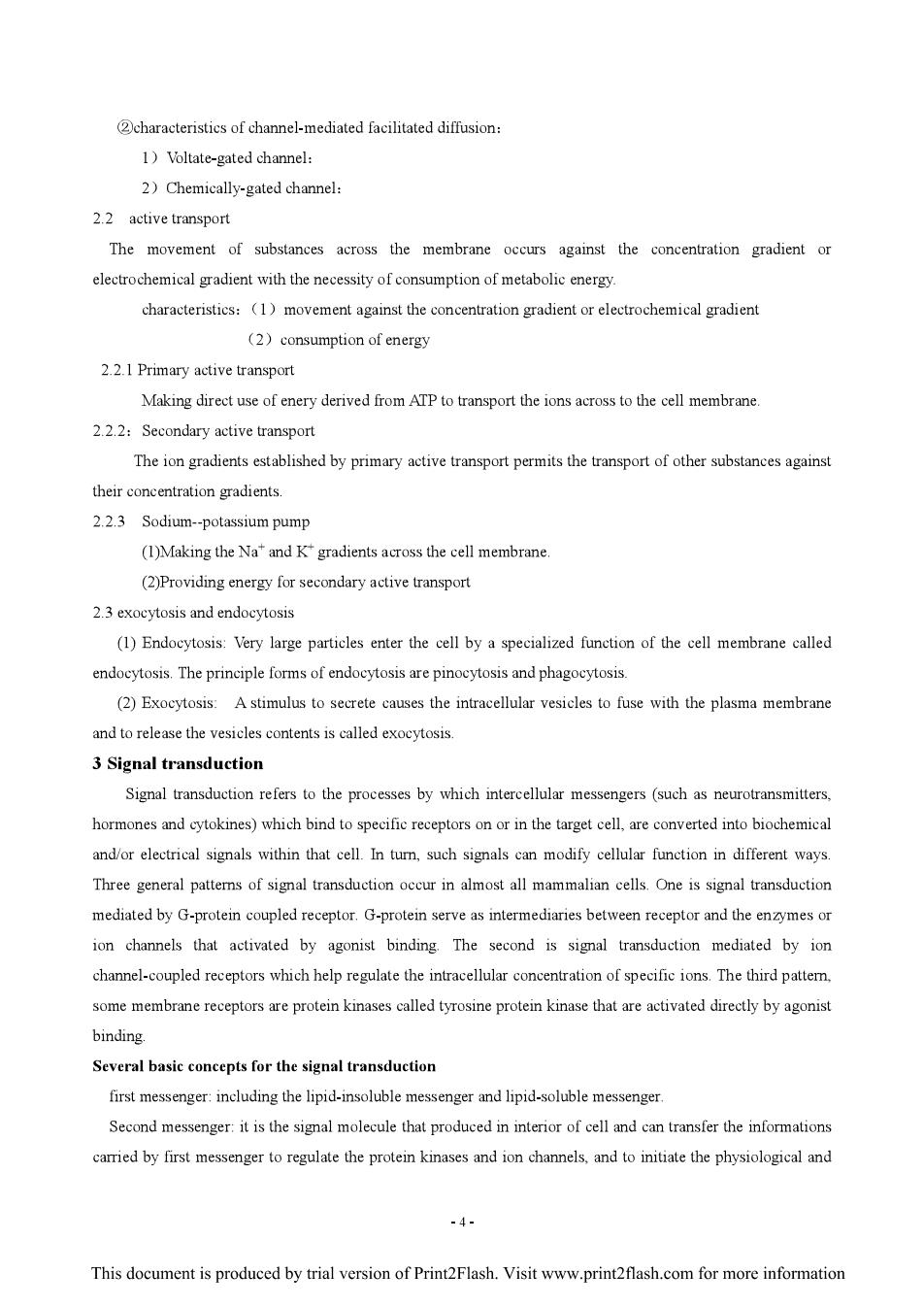
2characteristics of channel-mediated facilitated diffusion: 1)Voltate-gated channel: 2)Chemically-gated channel: 2.2 active transport The movement of substances across the membrane occurs against the concentration gradient or electrochemical gradient with the necessity of consumption of metabolic energy. characteristics:(1)movement against the concentration gradient or electrochemical gradient (2)consumption of energy 2.2.1 Primary active transport Making direct use of enery derived from ATP to transport the ions across to the cell membrane. 2.2.2:Secondary active transport The ion gradients established by primary active transport permits the transport of other substances against their concentration gradients. 2.2.3 Sodium--potassium pump (1)Making the Na'and K gradients across the cell membrane (2)Providing energy for secondary active transport 2.3 exocytosis and endocytosis (1)Endocytosis:Very large particles enter the cell by a specialized function of the cell membrane called endocytosis.The principle forms of endocytosis are pinocytosis and phagocytosis. (2)Exocytosis:A stimulus to secrete causes the intracellular vesicles to fuse with the plasma membrane and to release the vesicles contents is called exocytosis. 3 Signal transduction Signal transduction refers to the processes by which intercellular messengers (such as neurotransmitters, hormones and cytokines)which bind to specific receptors on or in the target cell,are converted into biochemical and/or electrical signals within that cell.In turn,such signals can modify cellular function in different ways. Three general patterns of signal transduction occur in almost all mammalian cells.One is signal transduction mediated by G-protein coupled receptor.G-protein serve as intermediaries between receptor and the enzymes or ion channels that activated by agonist binding.The second is signal transduction mediated by ion channel-coupled receptors which help regulate the intracellular concentration of specific ions.The third pattern. some membrane receptors are protein kinases called tyrosine protein kinase that are activated directly by agonist binding. Several basic concepts for the signal transduction first messenger:including the lipid-insoluble messenger and lipid-soluble messenger. Second messenger:it is the signal molecule that produced in interior of cell and can transfer the informations carried by first messenger to regulate the protein kinases and ion channels,and to initiate the physiological and -4- This document is produced by trial version of Print2Flash.Visit www.print2flash.com for more information

biochemical reactions.For example:cAMP,cGMP,IP3.DG,Ca2+etc. protein kinase:It can phosphorylate specific proteins,triggering biochemical reaction that lead to the cell's response to the hormone Signal transduction mediated by G-protein-linked receptor pathway Activation of the receptor by the binding of the first messenter allows the receptor to activate its associated G protein.The activeated G protein activate their effector protein,the adenylate cyclase(AC).The activated adenylyl cyclase the catalyzes the conversion of some intracellular ATP molecules to cAMP.The cAMP then acts as a second messenger to activate the protein kinase and,thereby,lead the phosphorylation of key proteins inside the cell. Seaction2 Excitation and Excitability of Cell 1 excitability and excitation excitability:Ability of living tissues or cells to response to external stimuli. New concept:ability to produce AP excitation:Old concept:from rest to activate or weaker activity to stronger activity New concept:can produce Action potential 1.1 Stimulus and excitation stimulus:The changes in internal or external environment that cause the body to response. Factors of eliciting excitation by stimulus (1)intensity: Threshold intensity(threshold):the minimum intensity to cause the tissues to be excited. Threshold stimulus:intensity-threshold subthreshold stimulus:intensity<threshold (2)duration:If the duration of stimulus is too short,very high intensity of stimulus fails to cause action potential Threshold time:the shortest time needed for eliciting excitation by certain intensity.the stronger the stimulus,the shorter the stimulating time,the opposite is true. (3)changes frequency of stimulus-time Rheobase:The minimum potential for producing stimulating effect by electrical current. 1.2Changes in excitability of the cell during the excitation and recovery states Dabsolute refractory period:Na+channel inactivation,excitability equal to zero 2relative refractory period:inactivated Na+channels begin to recover.It is possible to elicit a second action potential,but the threshold stimulus intensity is higher than usual. ③supranormal period: ④subnormal period: 2 Bioelectrical Phenomenon of cell -5- This document is produced by trial version of Print2Flash.Visit www.print2flash.com for more information
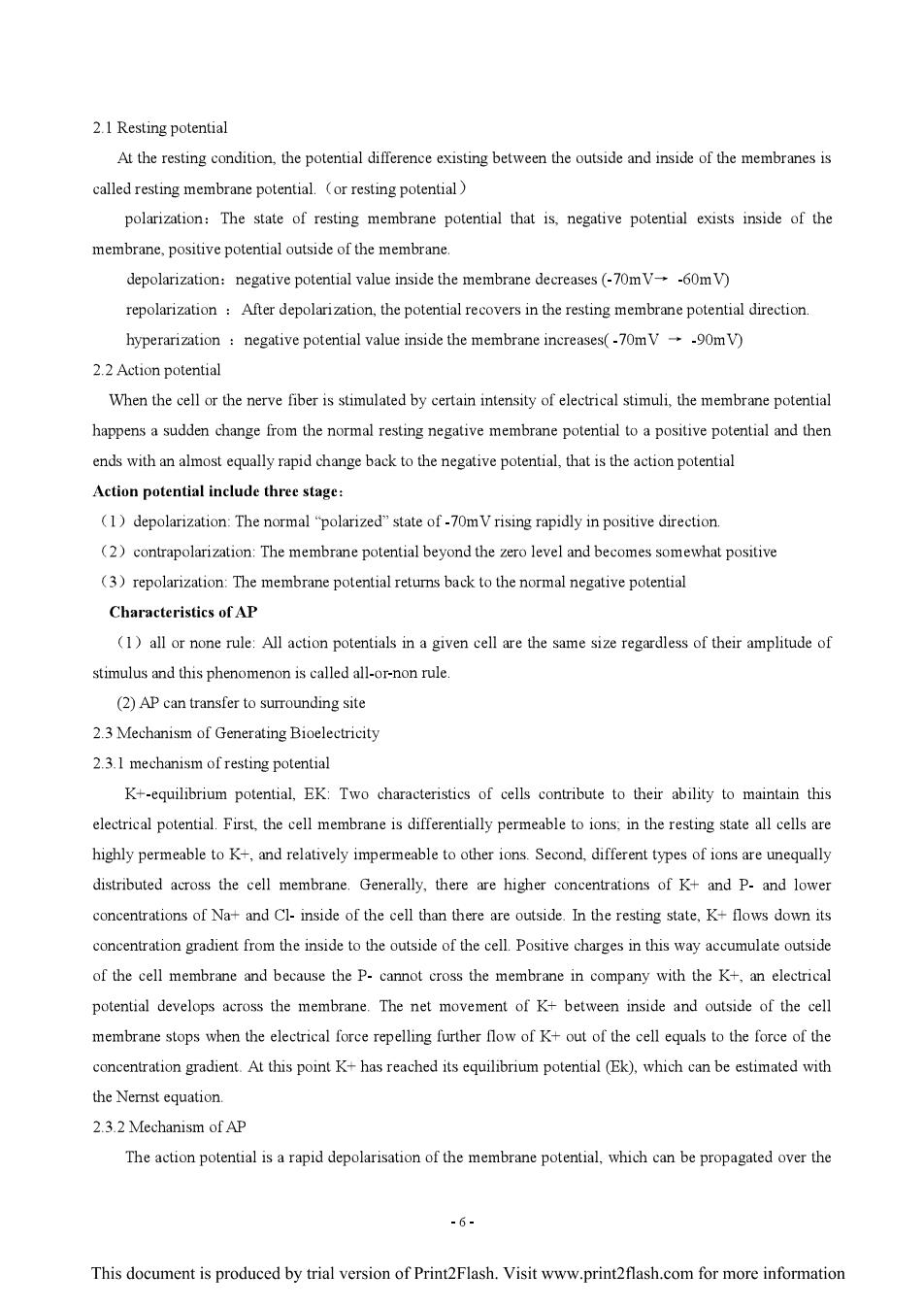
2.1 Resting potential At the resting condition,the potential difference existing between the outside and inside of the membranes is called resting membrane potential.(or resting potential) polarization:The state of resting membrane potential that is,negative potential exists inside of the membrane,positive potential outside of the membrane. depolarization:negative potential value inside the membrane decreases(-70mV--60mV) repolarization After depolarization,the potential recovers in the resting membrane potential direction. hyperarization negative potential value inside the membrane increases(-70mV--90mV) 2.2 Action potential When the cell or the nerve fiber is stimulated by certain intensity of electrical stimuli,the membrane potential happens a sudden change from the normal resting negative membrane potential to a positive potential and then ends with an almost equally rapid change back to the negative potential,that is the action potential Action potential include three stage: (1)depolarization:The normal "polarized"state of-70mV rising rapidly in positive direction. (2)contrapolarization:The membrane potential beyond the zero level and becomes somewhat positive (3)repolarization:The membrane potential returns back to the normal negative potential Characteristics of AP (1)all or none rule:All action potentials in a given cell are the same size regardless of their amplitude of stimulus and this phenomenon is called all-or-non rule (2)AP can transfer to surrounding site 2.3 Mechanism of Generating Bioelectricity 2.3.1 mechanism of resting potential K+-equilibrium potential,EK:Two characteristics of cells contribute to their ability to maintain this electrical potential.First,the cell membrane is differentially permeable to ions.in the resting state all cells are highly permeable to K+,and relatively impermeable to other ions.Second,different types of ions are unequally distributed across the cell membrane.Generally,there are higher concentrations of K+and P-and lower concentrations of Na+and Cl-inside of the cell than there are outside.In the resting state,K+flows down its concentration gradient from the inside to the outside of the cell.Positive charges in this way accumulate outside of the cell membrane and because the p-cannot cross the membrane in company with the K+,an electrical potential develops across the membrane.The net movement of K+between inside and outside of the cell membrane stops when the electrical force repelling further flow of K+out of the cell equals to the force of the concentration gradient.At this point K+has reached its equilibrium potential(Ek),which can be estimated with the Nernst equation 2.3.2 Mechanism of AP The action potential is a rapid depolarisation of the membrane potential,which can be propagated over the -6- This document is produced by trial version of Print2Flash.Visit www.print2flash.com for more information
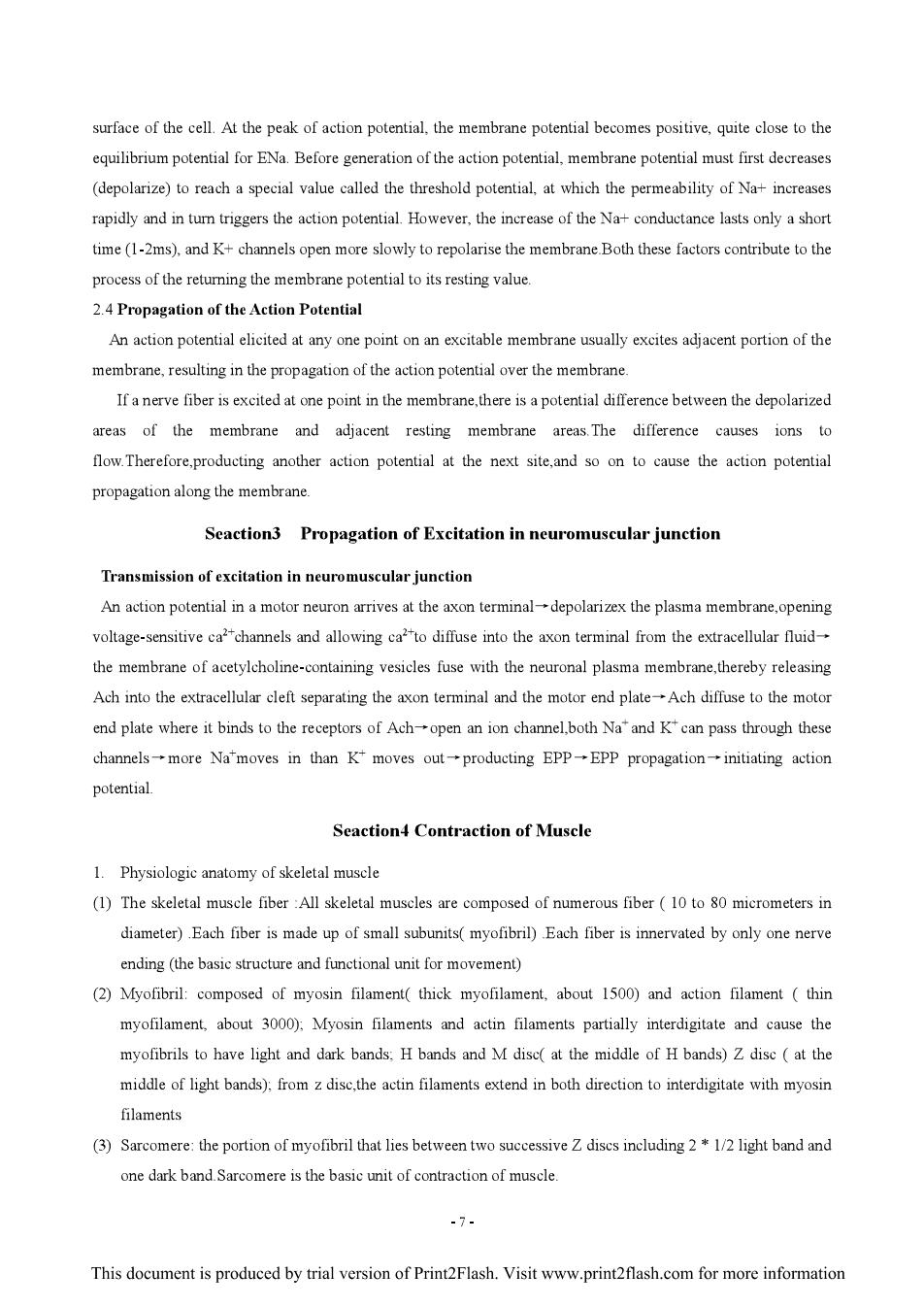
surface of the cell.At the peak of action potential.the membrane potential becomes positive,quite close to the equilibrium potential for ENa.Before generation of the action potential,membrane potential must first decreases (depolarize)to reach a special value called the threshold potential.at which the permeability of Na+increases rapidly and in turn triggers the action potential.However,the increase of the Na+conductance lasts only a short time(1-2ms),and K+channels open more slowly to repolarise the membrane Both these factors contribute to the process of the returning the membrane potential to its resting value. 2.4 Propagation of the Action Potential An action potential elicited at any one point on an excitable membrane usually excites adjacent portion of the membrane,resulting in the propagation of the action potential over the membrane. If a nerve fiber is excited at one point in the membrane,there is a potential difference between the depolarized areas of the membrane and adjacent resting membrane areas.The difference causes ions to flow.Therefore,producting another action potential at the next site,and so on to cause the action potential propagation along the membrane. Seaction3 Propagation of Excitation in neuromuscular junction Transmission of excitation in neuromuscular junction An action potential in a motor neuron arrives at the axon terminal-depolarizex the plasma membrane,opening voltage-sensitive ca2channels and allowing cato diffuse into the axon terminal from the extracellular fluid- the membrane of acetylcholine-containing vesicles fuse with the neuronal plasma membrane,thereby releasing Ach into the extracellular cleft separating the axon terminal and the motor end plate-Ach diffuse to the motor end plate where it binds to the receptors of Ach-open an ion channel.both Na'and K*can pass through these channels-more Na'moves in than K*moves out-producting EPP-EPP propagation-initiating action potential. Seaction4 Contraction of Muscle 1.Physiologic anatomy of skeletal muscle (1)The skeletal muscle fiber:All skeletal muscles are composed of numerous fiber 10 to 80 micrometers in diameter).Each fiber is made up of small subunits(myofibril)Each fiber is innervated by only one nerve ending (the basic structure and functional unit for movement) (2)Myofibril:composed of myosin filament(thick myofilament,about 1500)and action filament thin myofilament,about 3000);Myosin filaments and actin filaments partially interdigitate and cause the myofibrils to have light and dark bands:H bands and M disc(at the middle of H bands)Z disc at the middle of light bands);from z disc,the actin filaments extend in both direction to interdigitate with myosin filaments (3)Sarcomere:the portion of myofibril that lies between two successive Z discs including 2 1/2 light band and one dark band.Sarcomere is the basic unit of contraction of muscle. -7- This document is produced by trial version of Print2Flash.Visit www.print2flash.com for more information
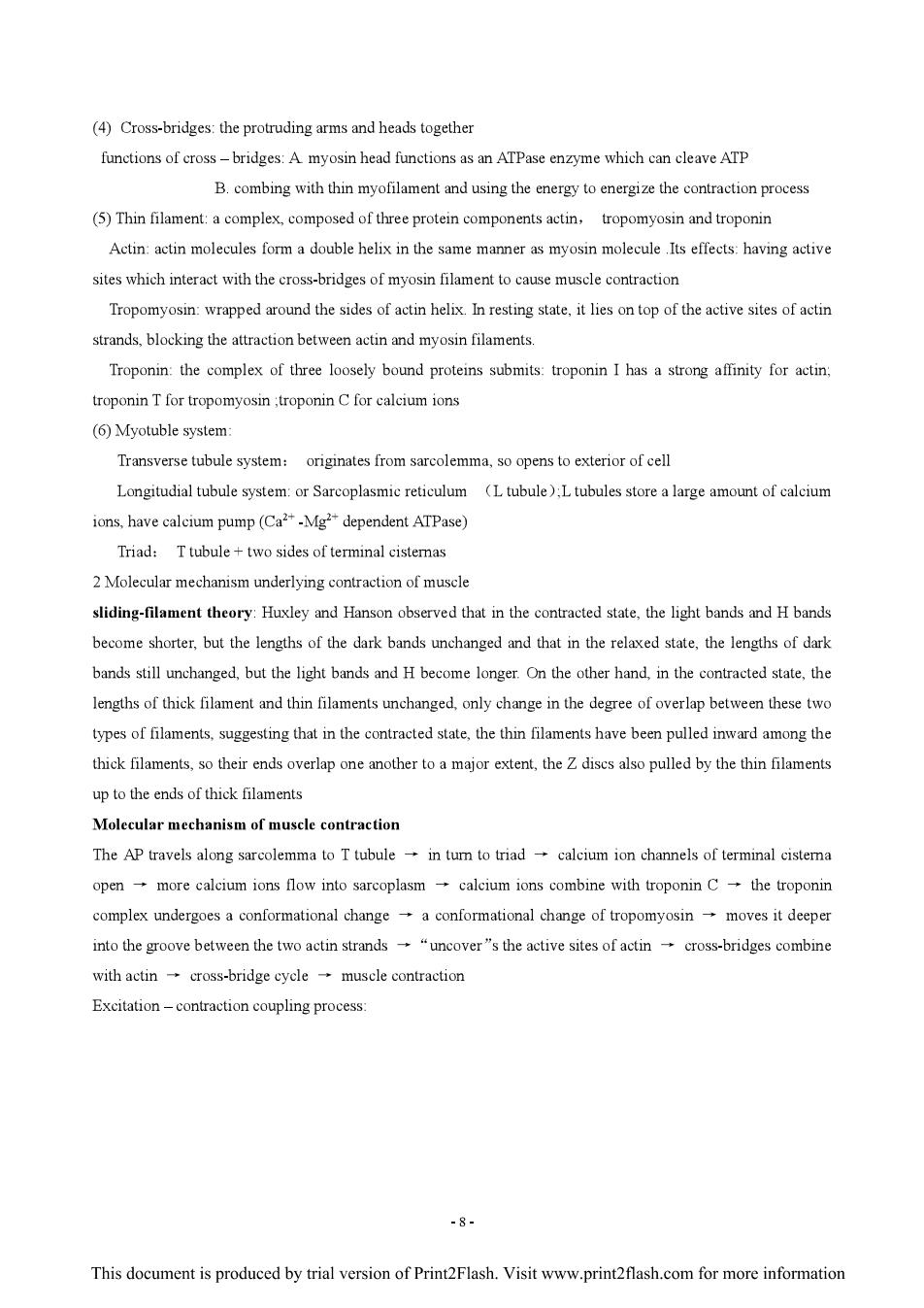
(4)Cross-bridges:the protruding arms and heads together functions of cross-bridges:A myosin head functions as an ATPase enzyme which can cleave ATP B.combing with thin myofilament and using the energy to energize the contraction process (5)Thin filament:a complex,composed of three protein components actin,tropomyosin and troponin Actin:actin molecules form a double helix in the same manner as myosin molecule.Its effects:having active sites which interact with the cross-bridges of myosin filament to cause muscle contraction Tropomyosin:wrapped around the sides of actin helix.In resting state,it lies on top of the active sites of actin strands,blocking the attraction between actin and myosin filaments. Troponin:the complex of three loosely bound proteins submits:troponin I has a strong affinity for actin; troponin T for tropomyosin ;troponin C for calcium ions (⑥Myotuble system: Transverse tubule system:originates from sarcolemma,so opens to exterior of cell Longitudial tubule system:or Sarcoplasmic reticulum (L tubule):L tubules store a large amount of calcium ions,have calcium pump(Ca2-Mg2*dependent ATPase) Triad:T tubule+two sides of terminal cisternas 2 Molecular mechanism underlying contraction of muscle sliding-filament theory:Huxley and Hanson observed that in the contracted state,the light bands and H bands become shorter,but the lengths of the dark bands unchanged and that in the relaxed state,the lengths of dark bands still unchanged,but the light bands and H become longer.On the other hand,in the contracted state,the lengths of thick filament and thin filaments unchanged,only change in the degree of overlap between these two types of filaments,suggesting that in the contracted state,the thin filaments have been pulled inward among the thick filaments,so their ends overlap one another to a major extent,the Z discs also pulled by the thin filaments up to the ends of thick filaments Molecular mechanism of muscle contraction The AP travels along sarcolemma to T tubule -in tumn to triad-calcium ion channels of terminal cisterna open-more calcium ions flow into sarcoplasm -calcium ions combine with troponin C-the troponin complex undergoes a conformational change-a conformational change of tropomyosin-moves it deeper into the groove between the two actin strands"uncover"s the active sites of actin cross-bridges combine with actin -cross-bridge cycle-muscle contraction Excitation-contraction coupling process: -8- This document is produced by trial version of Print2Flash.Visit www.print2flash.com for more information
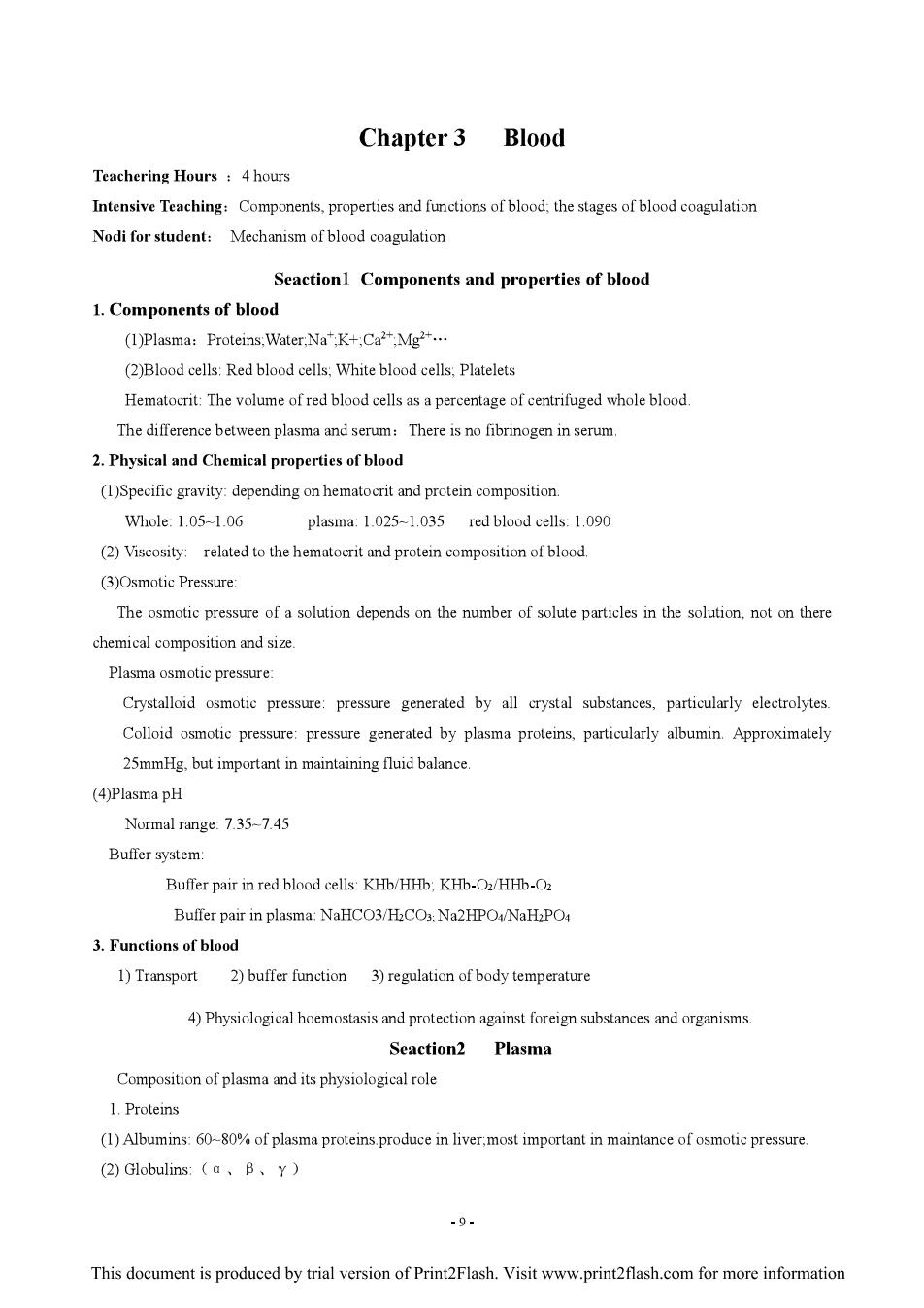
Chapter 3 Blood Teachering Hours 4 hours Intensive Teaching:Components,properties and functions of blood:the stages of blood coagulation Nodi for student:Mechanism of blood coagulation Seactionl Components and properties of blood 1.Components of blood (1)Plasma:Proteins:Water:NaK+:Ca2+:Mg2+... (2)Blood cells:Red blood cells;White blood cells:Platelets Hematocrit:The volume of red blood cells as a percentage of centrifuged whole blood. The difference between plasma and serum:There is no fibrinogen in serum. 2.Physical and Chemical properties of blood (1)Specific gravity:depending on hematocrit and protein composition. Whole:1.05-1.06 plasma:1.025-1.035 red blood cells:1.090 (2)Viscosity:related to the hematocrit and protein composition of blood. (3)Osmotic Pressure: The osmotic pressure of a solution depends on the number of solute particles in the solution,not on there chemical composition and size. Plasma osmotic pressure: Crystalloid osmotic pressure:pressure generated by all crystal substances,particularly electrolytes. Colloid osmotic pressure:pressure generated by plasma proteins,particularly albumin.Approximately 25mmHg,but important in maintaining fluid balance. (4)Plasma pH Normal range:7.35-7.45 Buffer system: Buffer pair in red blood cells:KHb/HHb;KHb-O2/HHb-Oz Buffer pair in plasma:NaHCO3/H2CO3:Na2HPO4/NaH2PO4 3.Functions of blood 1)Transport 2)buffer function 3)regulation of body temperature 4)Physiological hoemostasis and protection against foreign substances and organisms. Seaction2 Plasma Composition of plasma and its physiological role 1.Proteins (1)Albumins:60-80%of plasma proteins.produce in liver,most important in maintance of osmotic pressure. (2)Globulins:(a、B、Y) -9- This document is produced by trial version of Print2Flash.Visit www.print2flash.com for more information
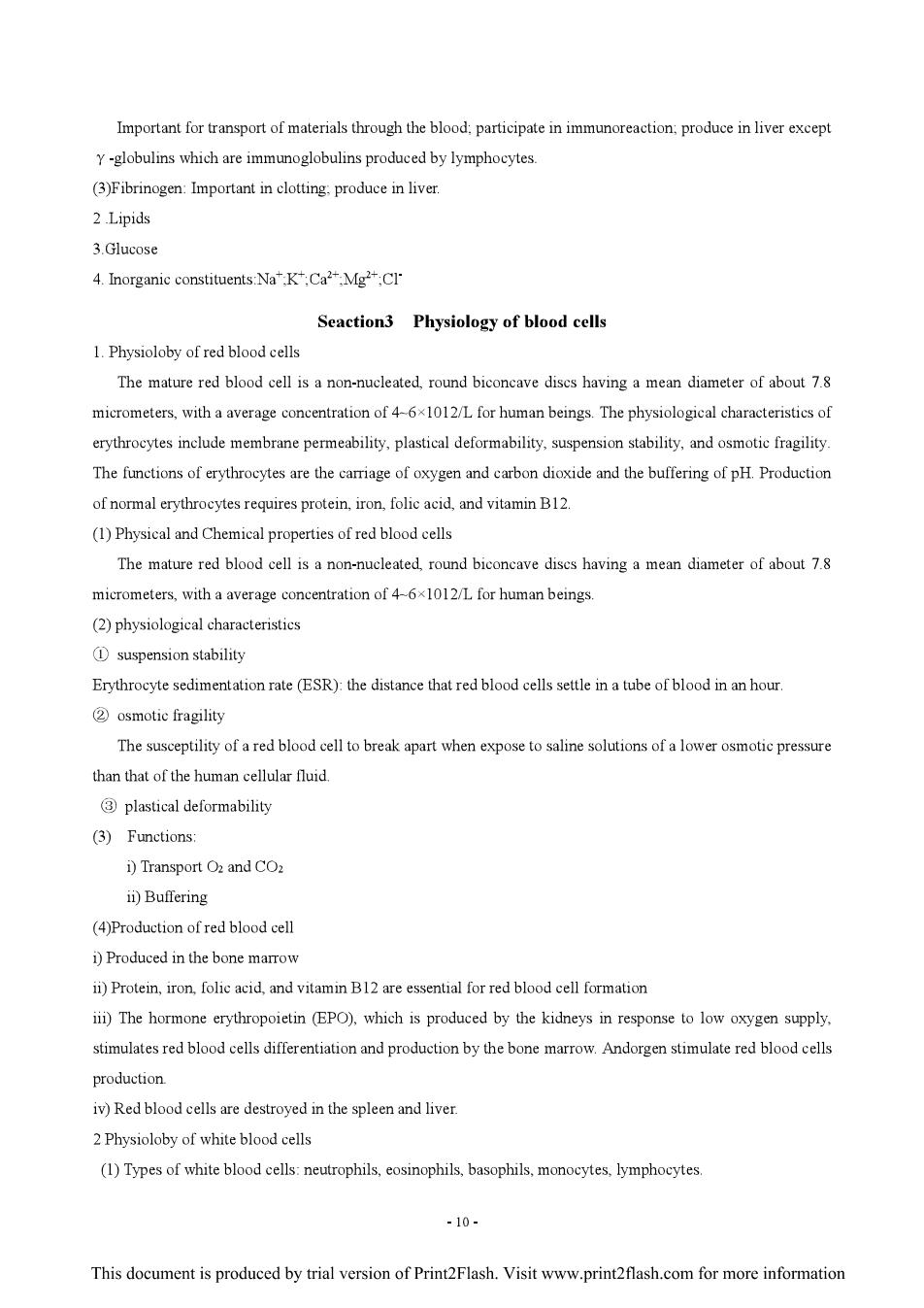
Important for transport of materials through the blood:participate in immunoreaction:produce in liver except Y-globulins which are immunoglobulins produced by lymphocytes. (3)Fibrinogen:Important in clotting.produce in liver. 2.Lipids 3.Glucose 4.Inorganic constituents:NaK:Ca2Mg2;Cl Seaction3 Physiology of blood cells 1.Physioloby of red blood cells The mature red blood cell is a non-nucleated,round biconcave discs having a mean diameter of about 7.8 micrometers,with a average concentration of 4-6x1012/L for human beings.The physiological characteristics of erythrocytes include membrane permeability,plastical deformability,suspension stability,and osmotic fragility. The functions of erythrocytes are the carriage of oxygen and carbon dioxide and the buffering of pH.Production of normal erythrocytes requires protein,iron,folic acid,and vitamin B12 (1)Physical and Chemical properties of red blood cells The mature red blood cell is a non-nucleated,round biconcave discs having a mean diameter of about 7.8 micrometers,with a average concentration of 4-6x1012/L for human beings. (2)physiological characteristics D suspension stability Erythrocyte sedimentation rate (ESR):the distance that red blood cells settle in a tube of blood in an hour. ②osmotic fragility The susceptility of a red blood cell to break apart when expose to saline solutions of a lower osmotic pressure than that of the human cellular fluid. 3 plastical deformability (3)Functions: )Transport O2 and CO2 ii)Buffering (4)Production of red blood cell i)Produced in the bone marrow ii)Protein,iron,folic acid,and vitamin B12 are essential for red blood cell formation iii)The hormone erythropoietin (EPO),which is produced by the kidneys in response to low oxygen supply. stimulates red blood cells differentiation and production by the bone marrow.Andorgen stimulate red blood cells production. iv)Red blood cells are destroyed in the spleen and liver. 2 Physioloby of white blood cells (1)Types of white blood cells:neutrophils,eosinophils,basophils,monocytes,lymphocytes. -10- This document is produced by trial version of Print2Flash.Visit www.print2flash.com for more information